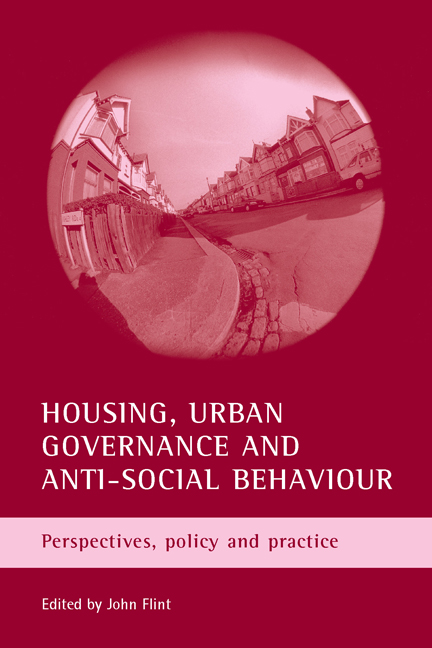Book contents
- Frontmatter
- Contents
- List of tables, figures and photographs
- Acknowledgements
- Notes on contributors
- Introduction
- Part 1 The definition and construction of anti-social behaviour in the UK
- Part 2 Legal techniques and measures utilised by social landlords to address anti-social behaviour
- Part 3 The emerging mechanisms of addressing anti-social behaviour in housing governance
- Part 4 Studies of housing and anti-social behaviour from an international perspective
- Index
five - Spaces of discipline and control: the compounded citizenship of social renting
Published online by Cambridge University Press: 15 January 2022
- Frontmatter
- Contents
- List of tables, figures and photographs
- Acknowledgements
- Notes on contributors
- Introduction
- Part 1 The definition and construction of anti-social behaviour in the UK
- Part 2 Legal techniques and measures utilised by social landlords to address anti-social behaviour
- Part 3 The emerging mechanisms of addressing anti-social behaviour in housing governance
- Part 4 Studies of housing and anti-social behaviour from an international perspective
- Index
Summary
Introduction
Safety is now top of both the domestic and international political agendas. A recent edition of The Economist (5 February 2005) gave front-cover prominence to the issue of anti-social behaviour (ASB) in the UK and drew parallels between it and international terrorism. One result of the high profile given to the crime and ASB agendas has been an attempt to locate and tackle those spaces most strongly associated with these problems via increasingly punitive measures. The aim of this chapter is to consider the way that an unwinding of this agenda has focused on areas of social rented housing through the coopting of residents of these areas as a means of tackling disorder. This connection, between poverty and ASB, can be seen in the key documents that set out the government's agenda:
[ASB] includes a range of problems – noisy neighbours, abandoned cars, aggressive begging, vandalism, graffiti, litter and youth nuisance. It can hold back the regeneration of our most disadvantaged areas, creating the environment in which crime can take hold. (See www.homeoffice.gov.uk/anti-social- behaviour/ for the Home Office ASB web pages.)
This agenda is focused on areas in which social housing predominates where it has become a key space within which a wider social politics of conduct is being played out (Flint, 2002). In this latter sense housing is a site of disciplinary action wherein certain behaviours have been increasingly delimited within wider normative frameworks (Ellison and Burrows, 2004). The current agenda of enforcement, punitive sanctions and being tough on the symptoms of social problems and ASB have made residential areas the primary spaces of control under a mantle of community empowerment. This chapter seeks to examine these issues in the context of spatial aspects of control implied by current policy developments while trying to consider the social forces that have given rise to the social geography of ASB.
Constituting the geography of anti-social behaviour
How then is the geography of ASB constituted and represented? A piece in a recent edition of the Daily Telegraph offered an unusual, but illuminating, commentary on ASB. It described the summer gathering of the University of Oxford's Bullingdon Club at which heavy drinking had led to fighting in a pub cellar which was ‘redecorated with clots of blood’ (Mount, 2004).
- Type
- Chapter
- Information
- Housing, Urban Governance and Anti-Social BehaviourPerspectives, Policy and Practice, pp. 99 - 116Publisher: Bristol University PressPrint publication year: 2006
- 1
- Cited by



